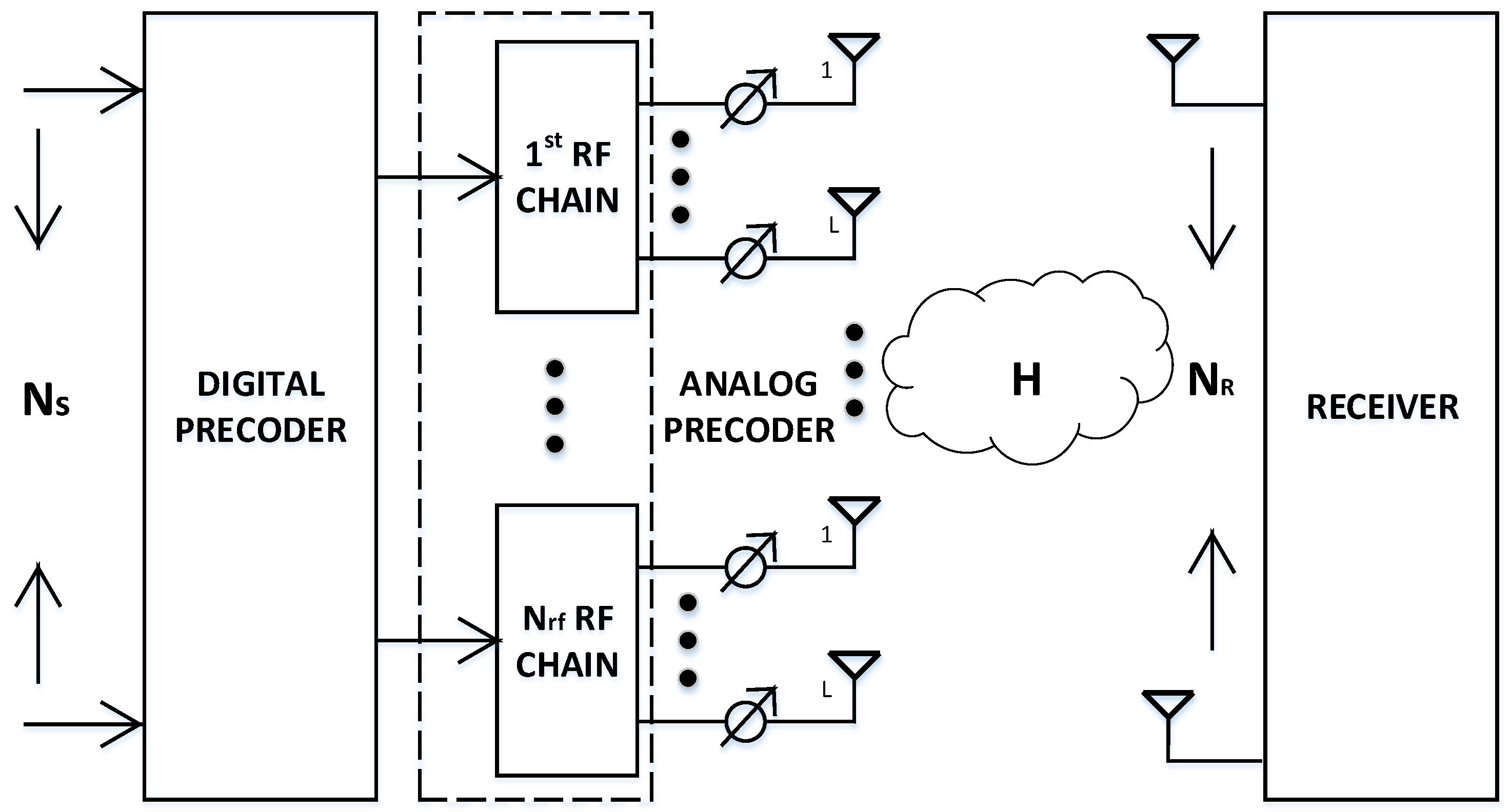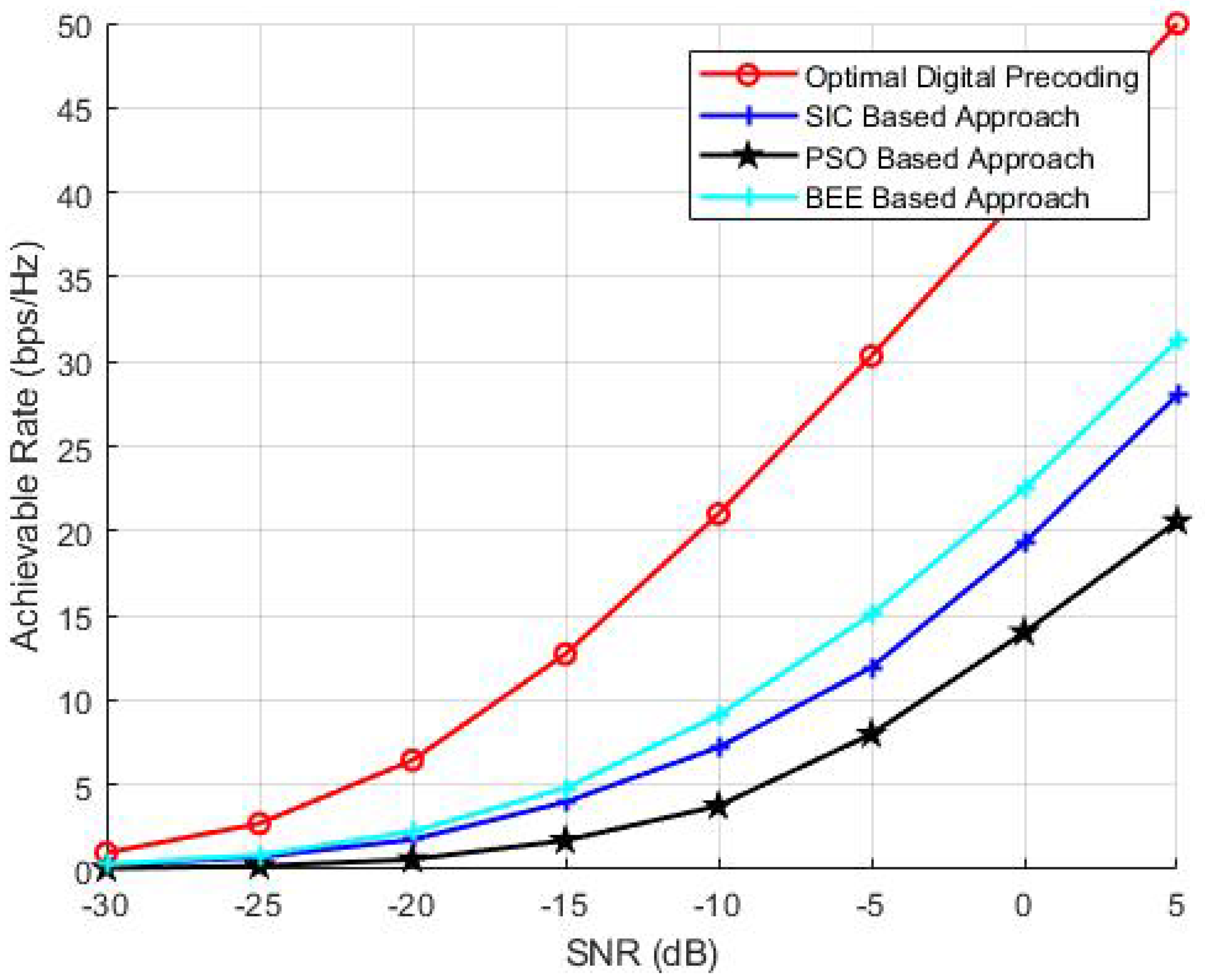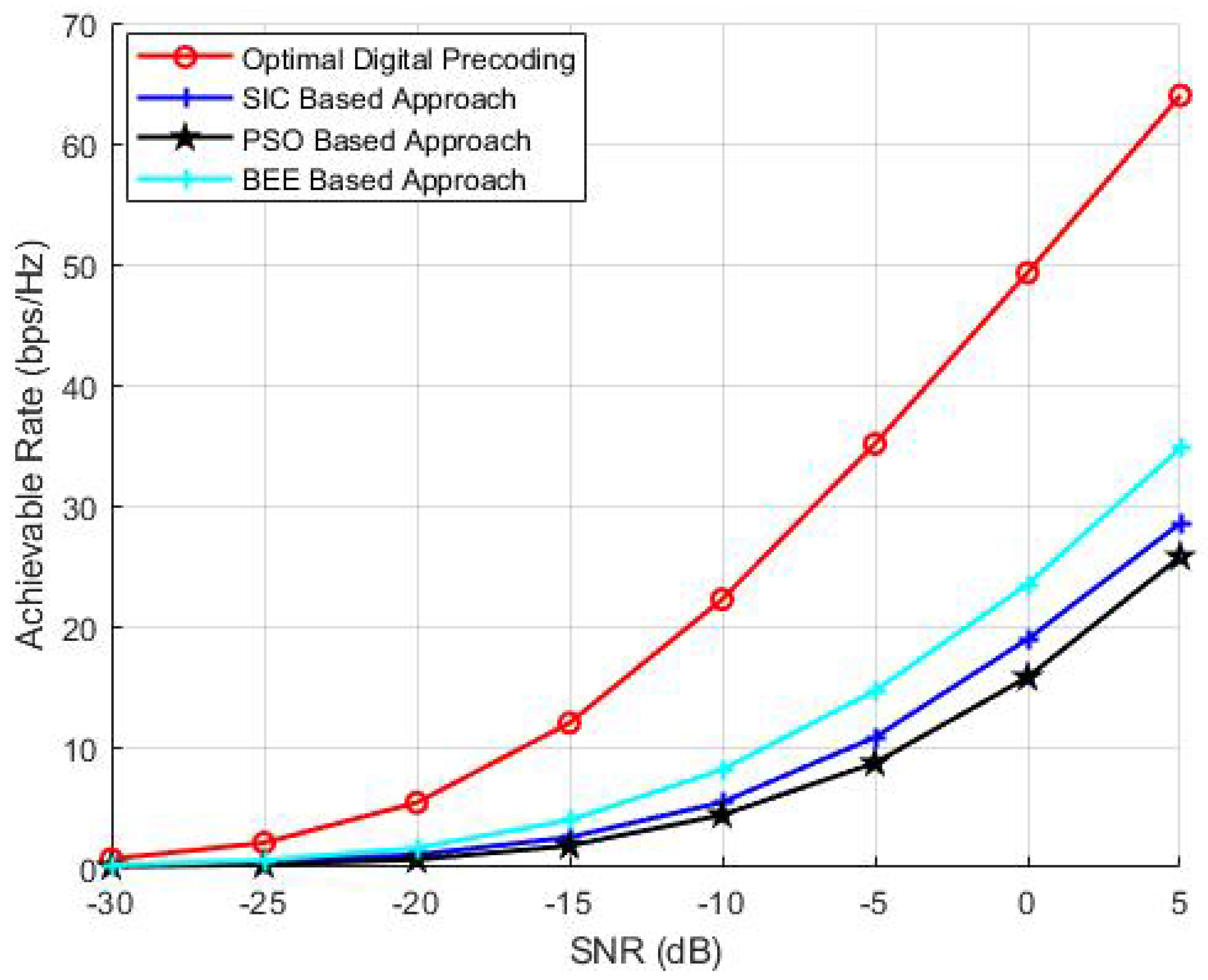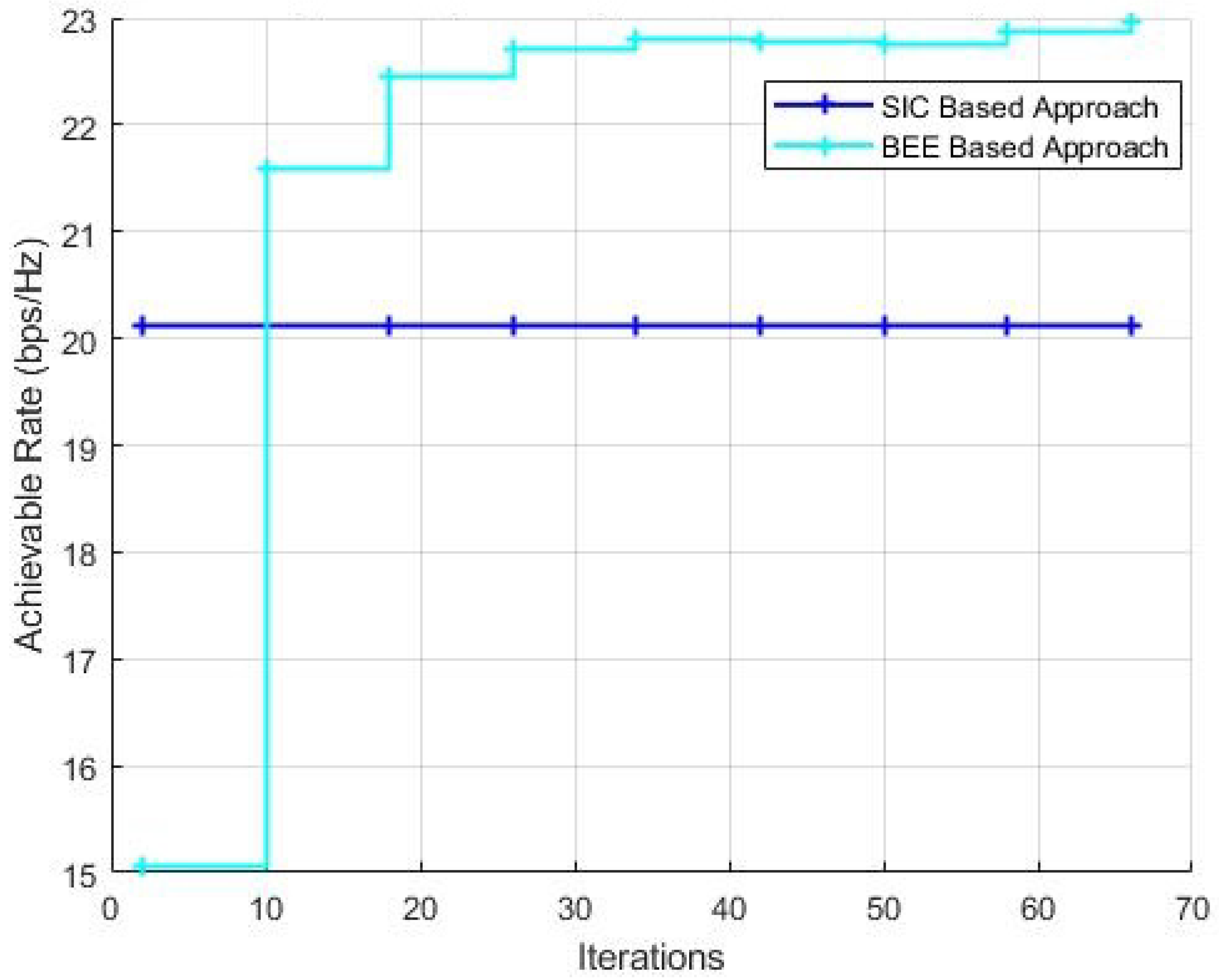Evolutionary Algorithm Based Capacity Maximization of 5G/B5G Hybrid Pre-Coding Systems
Abstract
1. Introduction
- We investigated the performance of evolutionary algorithms for capacity maximization and the results show that the proposed artificial bee colony (BEE) technique outclass other evolutionary algorithms in terms of achievable rate.
- We characterize the performance of pre-coding algorithms for different numbers of RF chains. It is shown that for a higher number of RF chains (where antennas per RF chain is reduced) BEE outperforms the SIC based technique for achievable rate, and the performance gap increases with the number of RF chains. Moreover, when the number of RF chains is less (where antennas per RF chains is high) the performance of the BEE algorithm is comparable to the SIC based approach for achievable rate. However, BEE outclasses all other evolutionary algorithms in every scenario.
- The performance of the proposed BEE algorithm is also investigated in the case of imperfect channel state information (CSI). Simulations results verify that the proposed algorithm is not overly sensitive to channel state information (CSI) accuracy.
2. System Model
3. Hybrid Pre-Coder Design Using Evolutionary Algorithm
- Evolutionary algorithms require minimal tuning parameters, therefore these algorithms can be implemented for real-time applications.
- Evolutionary algorithms only requires the fitness function and do not require any differentiation, matrix inversion and Singular Value Decomposition (SVD), hence, resulting in reduced complexity [45].
3.1. Artificial Bee Colony Optimization
| Algorithm 1. Artificial Bee Colony Optimization Algorithm |
| 1: for the n-th () RF chain do; |
| 2: (Step 1) Initialize: Generate food sources (current beam-forming vectors ) corresponding to ith source.; |
| 3: (Step 2) Evaluate The fitness of beam-forming vectors using (8); Corresponds to achievable rate and select |
| 4: while |
| 5: (Step 3) For each Employed Bee |
| 6: (a) Produce a new beam-forming vector using (9). |
| 7: (b) Evaluate its achievable rate using (8) |
| 8: (c) Choose the one (i.e., or ) that achieves higher rate. |
| 9: (Step 4) For each Onlooker Bee |
| 10: (a) Select a beam-forming vector depending on probability value. |
| 11: (b) Produce a new beam-forming vector using (9). |
| 12: (c) Evaluate its achievable rate using (8) |
| 13: (d) Choose the one (i.e., or ) that achieves higher rate.] |
| 14: (Step 5) Scout Bees Phase; Randomly Re-Initialize beam-forming vectors whose solutions cannot be improved after pre-determined trials and evaluate their achievable rate. |
| 15: (Step 6) Choose the best beam-forming vector based on maximum Achievable Rate. |
| 16: end while |
| 17: (Step 7) Decompose the best beam-forming vector into analogue and digital pre-coder
|
| 18: end for |
| 19: A = blkdiag[, , … , ]
|
| 20: D = diag[, , … , ]
|
3.2. Particle Swarm Optimization
| Algorithm 2. Particle Swarm Optimization Algorithm |
| 1: for the n-th () RF chain do; |
| 2: (Step 1) Initialize: Generate swarm positions (current beam-forming vectors ) corresponding to nth agent; |
| 3: (Step 2) Initialize: Generate swarm velocities () corresponds to nth agent; |
| 4: (Step 3) Evaluate the fitness (achievable rate) of each agent using (8) and determine the global best |
| 5: while do |
| 6: (Step 4) For each agent in the swarm |
| 7: (a) update the velocity and position of each agent as per the following iterative procedure
|
| 8: (b) Evaluate the fitness or achievable rate of each agent using (8) |
| 9: (c) if(agent current rate > agent best rate) (agent best fitness () = agent current fitness) |
| 10: (Step 5) end For |
| 11: (Step 6) Choose the best beam-forming vector based on maximum Achievable Rate. |
| 12: end while |
| 13: end for |
| 14: (Step 7) Decompose the best beam-forming vector into analogue and digital pre-coder
|
| 15: A = blkdiag[, , … , ]
|
| 16: D = diag[, , … , ]
|
4. Simulations and Results
4.1. Spectral Efficiency Analysis for Variable Transmit Antennas
4.2. Spectral Efficiency Analysis for Variable RF Chains and Evolutionary Algorithm Parameters
4.3. Performance Analysis with Imperfect CSI
4.4. Complexity Analysis
5. Conclusions
Author Contributions
Funding
Conflicts of Interest
References
- Rappaport, T.; Sun, S.; Mayzus, R.; Zhao, H.; Azar, Y.; Wang, K.; Wong, G.; Schulz, J.; Samimi, M.; Gutierrez, F. Millimeter wave mobile communications for 5G cellular: It will work! IEEE Access 2013, 1, 335–349. [Google Scholar] [CrossRef]
- Rangan, S.; Rappaport, T.; Erkip, E. Millimeter-wave cellular wireless networks: Potentials and challenges. Proc. IEEE 2014, 102, 366–385. [Google Scholar] [CrossRef]
- Sun, S.; Rappaport, T.S.; Heath, R.W.; Nix, A.; Rangan, S. MIMO for millimeter-wave wireless communications: Beamforming, spatial multiplexing, or both? IEEE Commun. Mag. 2014, 52, 110–121. [Google Scholar] [CrossRef]
- Hoydis, J.; Brink, S.T.; Debbah, M. Massive MIMO in the UL/DL of cellular networks: How many antennas do we need? IEEE J. Sel. Areas Commun. 2013, 31, 160–171. [Google Scholar] [CrossRef]
- Larsson, E.G.; Edfors, O.; Tufvesson, F.; Marzetta, T.L. Massive MIMO for next generation wireless systems. IEEE Commun. Mag. 2014, 52, 186–195. [Google Scholar] [CrossRef]
- Andrews, J.G.; Buzzi, S.; Choi, W.; Hanly, S.V.; Lozano, A.; Soong, A.C.K.; Zhang, J.C. What will 5G be? IEEE J. Sel. Areas Commun. 2014, 32, 1065–1082. [Google Scholar] [CrossRef]
- Boccardi, F.; Heath, R.W.; Lozano, A.; Marzetta, T.L.; Popovski, P. Five disruptive technology directions for 5G. IEEE Commun. Mag. 2014, 52, 74–80. [Google Scholar] [CrossRef]
- Björnson, E.; Sanguinetti, L.; Kountouris, M. Deploying dense networks for maximal energy efficiency: Small cells meet massive MIMO. IEEE J. Sel. Areas Commun. 2015, 34, 832–847. [Google Scholar] [CrossRef]
- Li, C.; Zhang, J.; Letaief, K.B. Throughput and energy efficiency analysis of small cell networks with multi-antenna base stations. IEEE Trans. Wirel. Commun. 2014, 13, 2505–2517. [Google Scholar]
- Roh, W.; Seol, J.Y.; Park, J.; Lee, B.; Lee, J.; Kim, Y.; Cho, J.; Cheun, K.; Aryanfar, F. Millimeter-wave beamforming as an enabling technology for 5G cellular communications: Theoretical feasibility and prototype results. IEEE Commun. Mag. 2014, 52, 106–113. [Google Scholar] [CrossRef]
- Bai, T.; Alkhateeb, A.; Heath, R. Coverage and capacity of millimeter-wave cellular networks. IEEE Commun. Mag. 2014, 52, 70–77. [Google Scholar]
- Pi, Z.; Khan, F. An introduction to millimeter-wave mobile broadband Systems. IEEE Commun. Mag. 2011, 49, 101–107. [Google Scholar] [CrossRef]
- Marzetta, T.L. Noncooperative cellular wireless with unlimited numbers of base station antennas. IEEE Trans. Wirel. Commun. 2010, 9, 3590–3600. [Google Scholar] [CrossRef]
- Ngo, H.; Larsson, E.; Marzetta, T. Energy and spectral efficiency of very large multiuser MIMO systems. IEEE Trans. Commun. 2012, 61, 1436–1449. [Google Scholar]
- Rusek, F.; Persson, D.; Lau, B.K.; Larsson, E.G.; Marzetta, T.L.; Edfors, O.; Tufvesson, F. Scaling up MIMO: Opportunities and challenges with very large arrays. IEEE Signal Process. Mag. 2013, 30, 40–60. [Google Scholar] [CrossRef]
- Wei, L.; Hu, R.Q.; Qian, Y.; Wu, G. Key elements to enable millimeter wave communications for 5G wireless systems. IEEE Wirel. Commun. 2014, 21, 136–143. [Google Scholar]
- Alkhateeb, A.; Mo, J.; González-Prelcic, N.; Heath, R. MIMO precoding and combining solutions for millimeter-wave systems. IEEE Commun. Mag. 2014, 52, 122–131. [Google Scholar] [CrossRef]
- Yin, B.; Abu-Surra, S.; Xu, G.; Henige, T.; Pisek, E.; Pi, Z.; Cavallaro, J.R. High-throughput beamforming receiver for millimeter wave mobile communication. In Proceedings of the 2013 IEEE Global Communications Conference (GLOBECOM’13), Atlanta, GA, USA, 9–13 December 2013; pp. 3697–3702. [Google Scholar]
- Abbas, W.B.; Gomez-Cuba, F.; Zorzi, M. Millimeter Wave Receiver Efficiency: A Comprehensive Comparison of Beamforming Schemes With Low Resolution ADCs. IEEE Trans. Wirel. Commun. 2017, 16, 8131–8146. [Google Scholar] [CrossRef]
- Han, S.; Chih-Lin, I.; Xu, Z.; Rowell, C. Large-scale antenna systems with hybrid precoding analog and digital beamforming for millimeter wave 5G. IEEE Commun. Mag. 2015, 53, 186–194. [Google Scholar] [CrossRef]
- El Ayach, O.; Rajagopal, S.; Abu-Surra, S.; Pi, Z.; Heath, R.W. Spatially sparse precoding in millimeter wave MIMO systems. IEEE Trans. Wirel. Commun. 2014, 13, 1499–1513. [Google Scholar] [CrossRef]
- Chen, C. An iterative hybrid transceiver design algorithm for millimeter wave MIMO systems. IEEE Wirel. Commun. Lett. 2015, 4, 285–288. [Google Scholar] [CrossRef]
- Lee, Y.Y.; Wang, C.H.; Huang, Y.H. A hybrid RF/baseband precoding processor based on parallel-index-selection matrix-inversion-bypass simultaneous orthogonal matching pursuit for millimeter wave MIMO systems. IEEE Trans. Signal Process. 2015, 63, 305–317. [Google Scholar] [CrossRef]
- Kim, C.; Son, J.S.; Kim, T.; Seol, J.Y. On the hybrid beamforming with shared array antenna for mmWave MIMO-OFDM systems. In Proceedings of the 2014 IEEE Wireless Communications and Networking Conference (WCNC), Istanbul, Turkey, 6–9 April 2014. [Google Scholar]
- Khalid, F. Hybrid Beamforming for Millimeter Wave Massive Multiuser MIMO Systems Using Regularized Channel Diagonalization. IEEE Wirel. Commun. Lett. 2019, 8, 705–708. [Google Scholar] [CrossRef]
- Gao, X.; Dai, L.; Han, S.; Chih-Lin, I.; Heath, R.W. Energy-efficient hybrid analog and digital precoding for mmWave MIMO systems with large antenna arrays. IEEE J. Sel. Areas Commun. 2016, 34, 998–1009. [Google Scholar] [CrossRef]
- Dai, L.; Gao, X.; Quan, J.; Han, S.; Chih-Lin, I. Near-optimal hybrid analog and digital precoding for downlink mmwave massive mimo systems. In Proceedings of the 2015 IEEE International Conference on Communications (ICC), London, UK, 8–12 June 2015; pp. 1334–1339. [Google Scholar]
- Zhang, D.; Wang, Y.; Li, X.; Xiang, W. Hybridly Connected Structure for Hybrid Beamforming in mmWave Massive MIMO Systems. IEEE Trans. Commun. 2018, 66, 662–674. [Google Scholar] [CrossRef]
- Zhang, J.; Huang, Y.; Yu, T.; Wang, J.; Xiao, M. Hybrid Precoding for Multi-Subarray Millimeter-Wave Communication Systems. IEEE Wirel. Commun. Lett. 2018, 7, 440–443. [Google Scholar] [CrossRef]
- Alluhaibi, O.; Ahmed, Q.Z.; Wang, J.; Zhu, H. Hybrid digital-to-analog precoding design for mm-wave systems. In Proceedings of the 2017 IEEE International Conference on Communications (ICC), Paris, France, 21–25 May 2017; pp. 1–6. [Google Scholar]
- Yu, X.; Shen, J.C.; Zhang, J.; Letaief, K.B. Alternating Minimization Algorithms for Hybrid Precoding in Millimeter Wave MIMO Systems. IEEE J. Sel. Top. Signal Process. 2016, 10, 485–500. [Google Scholar] [CrossRef]
- Alluhaibi, O.; Nair, M.; Hazzaa, A.; Mihbarey, A.; Wang, J. 3D Beamforming for 5G Millimeter Wave Systems Using Singular Value Decomposition and Particle Swarm Optimization Approaches. In Proceedings of the International Conference on Information and Communication Technology Convergence (ICTC), Jeju, Korea, 17–19 October 2018; pp. 15–19. [Google Scholar]
- Alluhaibi, O.; Ahmed, Q.Z.; Pan, C.; Zhu, H. Hybrid Digital-to-Analog Beamforming Approaches to Maximise the Capacity of mm-Wave Systems. In Proceedings of the IEEE 85th Vehicular Technology Conference (VTC Spring), Sydney, Australia, 4–7 June 2017; pp. 1–5. [Google Scholar]
- Xie, Y.; Li, B.; Yan, Z.; Fan, J.; Yang, M. A General Hybrid Precoding Method for mmWave Massive MIMO Systems. Radio Eng. 2019, 28, 439–446. [Google Scholar] [CrossRef]
- Liu, X.; Li, X.; Cao, S.; Deng, Q.; Ran, R.; Nguyen, K.; Tingrui, P. Hybrid Precoding for Massive mmWave MIMO Systems. IEEE Access 2019, 7, 33577–33586. [Google Scholar] [CrossRef]
- Kolawole, O.Y.; Biswas, S.; Singh, K.; Ratnarajah, T. Transceiver Design for Energy-Efficiency Maximization in mmWave MIMO IoT Networks. IEEE Trans. Green Commun. Netw. 2020, 4, 109–123. [Google Scholar] [CrossRef]
- Zhao, P.; Wang, Z. Hybrid Precoding for Millimeter Wave Communications With Fully Connected Subarrays. IEEE Commun. Lett. 2018, 22, 2160–2163. [Google Scholar] [CrossRef]
- Majidzadeh, M.; Kaleva, J.; Tervo, N.; Pennanen, H.; Tölli, A.; Latva-Aho, M. Rate Maximization for Partially Connected Hybrid Beamforming in Single-User MIMO Systems. In Proceedings of the IEEE 19th International Workshop on Signal Processing Advances in Wireless Communications (SPAWC), Kalamata, Greece, 25–28 June 2018; pp. 1–5. [Google Scholar]
- Nair, M.; Ahmed, Q.Z.; Wang, J.; Zhu, H. Low-Complexity Hybrid Digital-to-Analog Beamforming for Millimeter-Wave Systems with High User Density. In Proceedings of the IEEE 85th Vehicular Technology Conference (VTC Spring), Sydney, Australia, 4–7 June 2017; pp. 1–5. [Google Scholar]
- Alluhaibi, O.; Ahmed, Q.Z. Multi-User Hybrid Precoding and Decoding Design for mm-Wave Large Antenna Systems. In Proceedings of the IEEE 87th Vehicular Technology Conference (VTC Spring), Porto, Portugal, 3–6 June 2018; pp. 1–5. [Google Scholar]
- Elbir, A.M.; Mishra, K.V. Joint Antenna Selection and Hybrid Beamformer Design Using Unquantized and Quantized Deep Learning Networks. IEEE Trans. Wirel. Commun. 2020, 19, 1677–1688. [Google Scholar] [CrossRef]
- Choi, J.; Lee, N.; Hong, S.; Caire, G. Joint User Selection, Power Allocation, and Precoding Design With Imperfect CSIT for Multi-Cell MU-MIMO Downlink Systems. IEEE Trans. Wirel. Commun. 2020, 19, 162–176. [Google Scholar] [CrossRef]
- Han, S.; Chih-Lin, I.; Xu, Z.; Wang, S. Reference signals design for hybrid analog and digital beamforming. IEEE Commun. Lett. 2014, 18, 1191–1193. [Google Scholar] [CrossRef]
- Alkhateeb, A.; El Ayach, O.; Leus, G.; Heath, R.W. Channel estimation and hybrid precoding for millimeter wave cellular systems. IEEE J. Sel. Top. Signal Process. 2014, 8, 831–846. [Google Scholar] [CrossRef]
- Yang, X.-S. Nature-Inspired Optimization Algorithms, 1st ed.; Elsevier: Amsterdam, The Netherlands, 2014; ISBN 9780124167438. [Google Scholar] [CrossRef]












© 2020 by the authors. Licensee MDPI, Basel, Switzerland. This article is an open access article distributed under the terms and conditions of the Creative Commons Attribution (CC BY) license (http://creativecommons.org/licenses/by/4.0/).
Share and Cite
Khalid, S.; Abbas, W.B.; Kim, H.S.; Niaz, M.T. Evolutionary Algorithm Based Capacity Maximization of 5G/B5G Hybrid Pre-Coding Systems. Sensors 2020, 20, 5338. https://doi.org/10.3390/s20185338
Khalid S, Abbas WB, Kim HS, Niaz MT. Evolutionary Algorithm Based Capacity Maximization of 5G/B5G Hybrid Pre-Coding Systems. Sensors. 2020; 20(18):5338. https://doi.org/10.3390/s20185338
Chicago/Turabian StyleKhalid, Salman, Waqas Bin Abbas, Hyung Seok Kim, and Muhammad Tabish Niaz. 2020. "Evolutionary Algorithm Based Capacity Maximization of 5G/B5G Hybrid Pre-Coding Systems" Sensors 20, no. 18: 5338. https://doi.org/10.3390/s20185338
APA StyleKhalid, S., Abbas, W. B., Kim, H. S., & Niaz, M. T. (2020). Evolutionary Algorithm Based Capacity Maximization of 5G/B5G Hybrid Pre-Coding Systems. Sensors, 20(18), 5338. https://doi.org/10.3390/s20185338





